RENAULT SCENIC 2011 J95 / 3.G Engine And Peripherals EDC16 User Guide
Manufacturer: RENAULT, Model Year: 2011, Model line: SCENIC, Model: RENAULT SCENIC 2011 J95 / 3.GPages: 365, PDF Size: 2.11 MB
Page 11 of 365
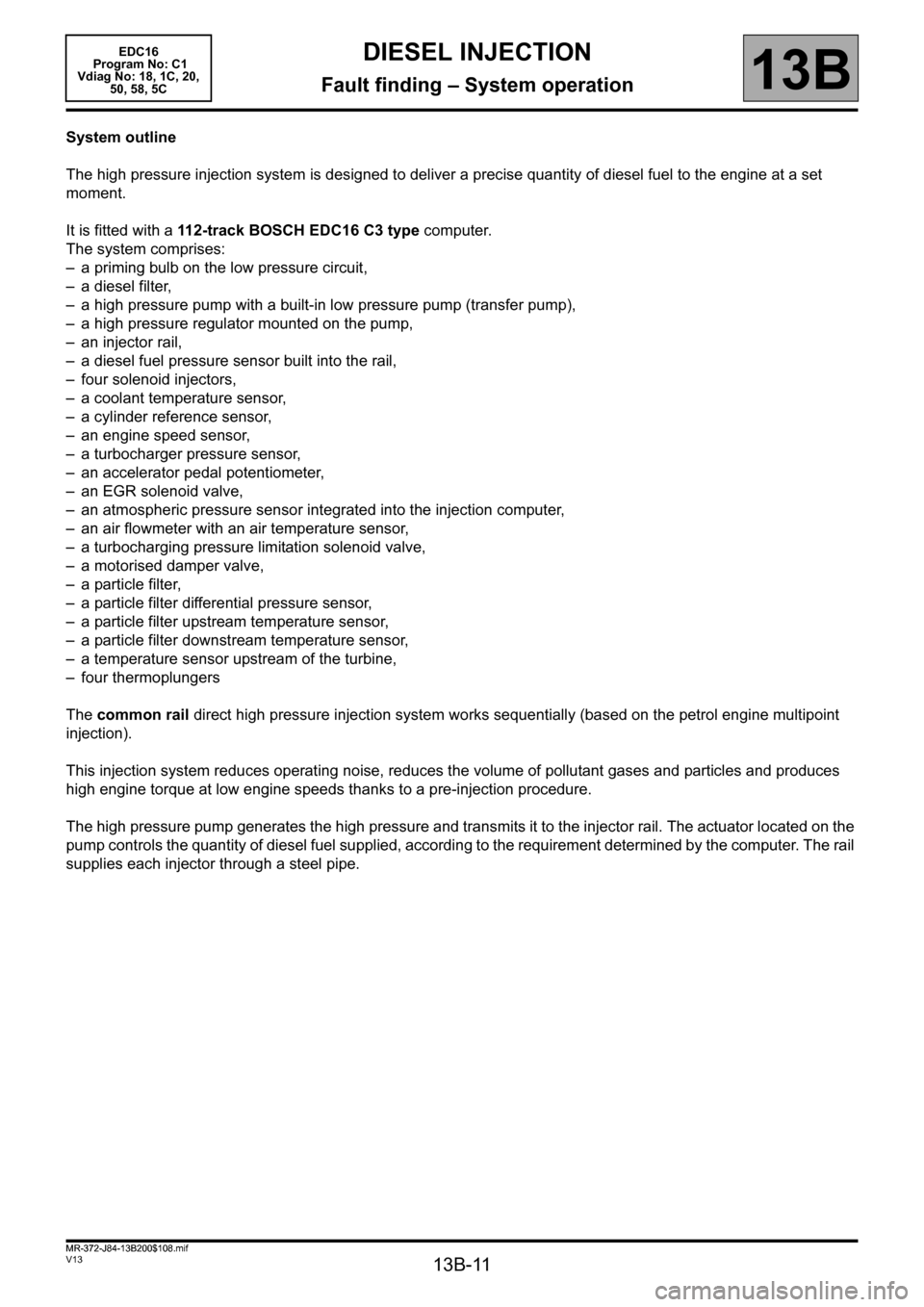
13B-11
MR-372-J84-13B200$108.mif
V13
13B
DIESEL INJECTION
Fault finding – System operation
System outline
The high pressure injection system is designed to deliver a precise quantity of diesel fuel to the engine at a set
moment.
It is fitted with a 112-track BOSCH EDC16 C3 type computer.
The system comprises:
– a priming bulb on the low pressure circuit,
– a diesel filter,
– a high pressure pump with a built-in low pressure pump (transfer pump),
– a high pressure regulator mounted on the pump,
– an injector rail,
– a diesel fuel pressure sensor built into the rail,
– four solenoid injectors,
– a coolant temperature sensor,
– a cylinder reference sensor,
– an engine speed sensor,
– a turbocharger pressure sensor,
– an accelerator pedal potentiometer,
– an EGR solenoid valve,
– an atmospheric pressure sensor integrated into the injection computer,
– an air flowmeter with an air temperature sensor,
– a turbocharging pressure limitation solenoid valve,
– a motorised damper valve,
– a particle filter,
– a particle filter differential pressure sensor,
– a particle filter upstream temperature sensor,
– a particle filter downstream temperature sensor,
– a temperature sensor upstream of the turbine,
– four thermoplungers
The common rail direct high pressure injection system works sequentially (based on the petrol engine multipoint
injection).
This injection system reduces operating noise, reduces the volume of pollutant gases and particles and produces
high engine torque at low engine speeds thanks to a pre-injection procedure.
The high pressure pump generates the high pressure and transmits it to the injector rail. The actuator located on the
pump controls the quantity of diesel fuel supplied, according to the requirement determined by the computer. The rail
supplies each injector through a steel pipe.
MR-372-J84-13B200$108.mif
EDC16
Program No: C1
Vdiag No: 18, 1C, 20,
50, 58, 5C
Page 12 of 365
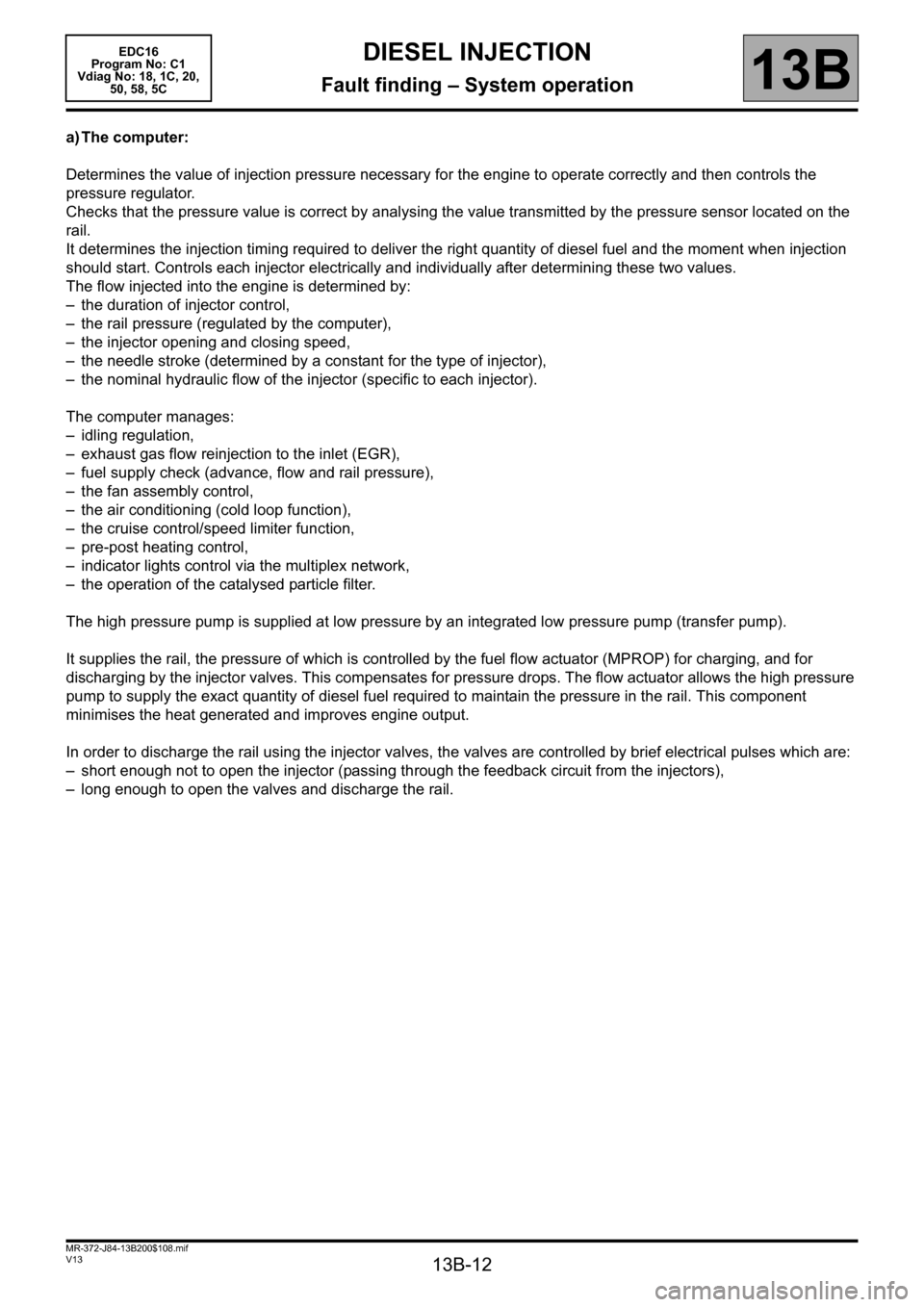
13B-12
MR-372-J84-13B200$108.mif
V13
DIESEL INJECTION
Fault finding – System operation
EDC16
Program No: C1
Vdiag No: 18, 1C, 20,
50, 58, 5C
13B
a) The computer:
Determines the value of injection pressure necessary for the engine to operate correctly and then controls the
pressure regulator.
Checks that the pressure value is correct by analysing the value transmitted by the pressure sensor located on the
rail.
It determines the injection timing required to deliver the right quantity of diesel fuel and the moment when injection
should start. Controls each injector electrically and individually after determining these two values.
The flow injected into the engine is determined by:
– the duration of injector control,
– the rail pressure (regulated by the computer),
– the injector opening and closing speed,
– the needle stroke (determined by a constant for the type of injector),
– the nominal hydraulic flow of the injector (specific to each injector).
The computer manages:
– idling regulation,
– exhaust gas flow reinjection to the inlet (EGR),
– fuel supply check (advance, flow and rail pressure),
– the fan assembly control,
– the air conditioning (cold loop function),
– the cruise control/speed limiter function,
– pre-post heating control,
– indicator lights control via the multiplex network,
– the operation of the catalysed particle filter.
The high pressure pump is supplied at low pressure by an integrated low pressure pump (transfer pump).
It supplies the rail, the pressure of which is controlled by the fuel flow actuator (MPROP) for charging, and for
discharging by the injector valves. This compensates for pressure drops. The flow actuator allows the high pressure
pump to supply the exact quantity of diesel fuel required to maintain the pressure in the rail. This component
minimises the heat generated and improves engine output.
In order to discharge the rail using the injector valves, the valves are controlled by brief electrical pulses which are:
– short enough not to open the injector (passing through the feedback circuit from the injectors),
– long enough to open the valves and discharge the rail.
Page 13 of 365
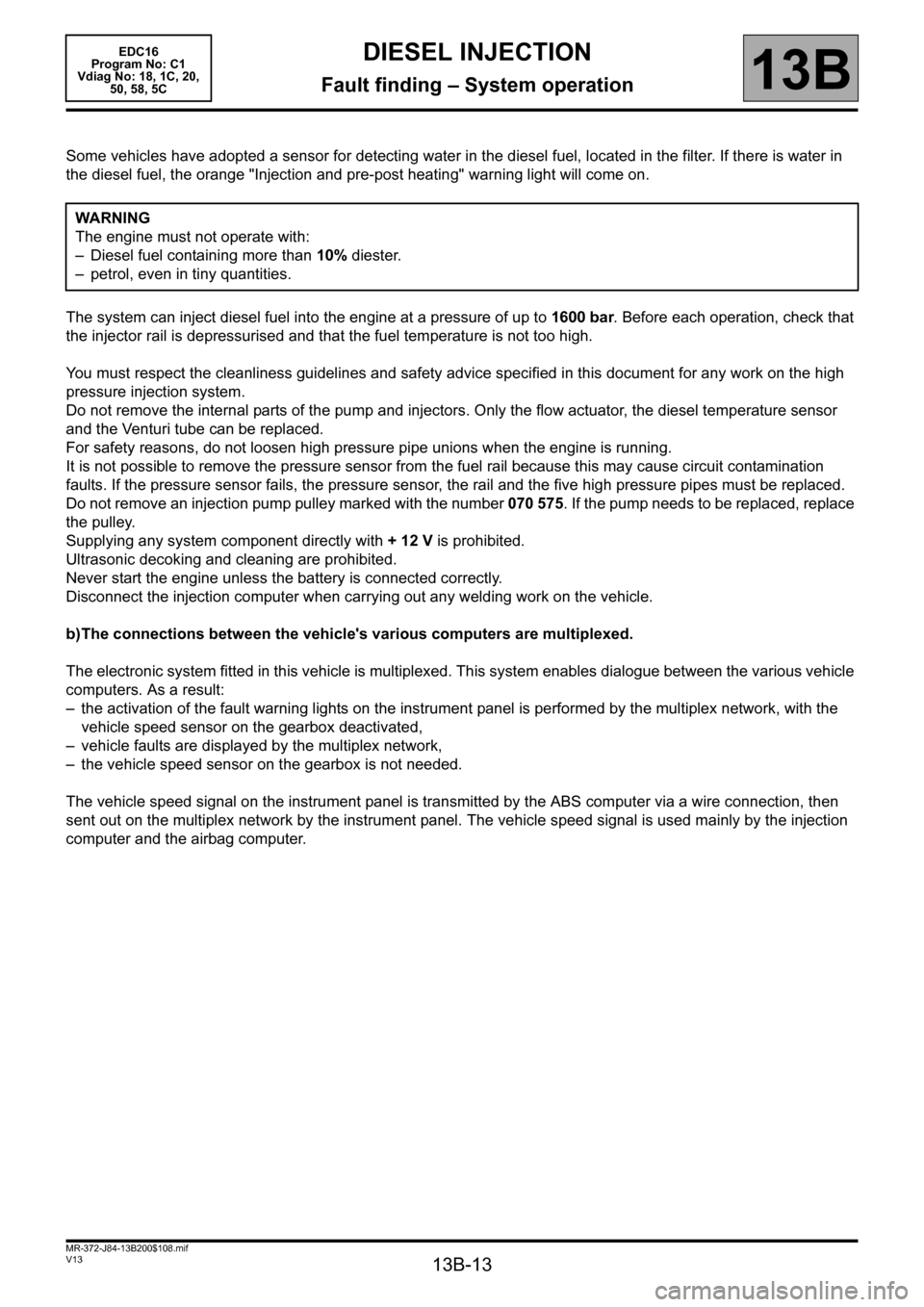
13B-13
MR-372-J84-13B200$108.mif
V13
DIESEL INJECTION
Fault finding – System operation
EDC16
Program No: C1
Vdiag No: 18, 1C, 20,
50, 58, 5C
13B
Some vehicles have adopted a sensor for detecting water in the diesel fuel, located in the filter. If there is water in
the diesel fuel, the orange "Injection and pre-post heating" warning light will come on.
The system can inject diesel fuel into the engine at a pressure of up to 1600 bar. Before each operation, check that
the injector rail is depressurised and that the fuel temperature is not too high.
You must respect the cleanliness guidelines and safety advice specified in this document for any work on the high
pressure injection system.
Do not remove the internal parts of the pump and injectors. Only the flow actuator, the diesel temperature sensor
and the Venturi tube can be replaced.
For safety reasons, do not loosen high pressure pipe unions when the engine is running.
It is not possible to remove the pressure sensor from the fuel rail because this may cause circuit contamination
faults. If the pressure sensor fails, the pressure sensor, the rail and the five high pressure pipes must be replaced.
Do not remove an injection pump pulley marked with the number 070 575. If the pump needs to be replaced, replace
the pulley.
Supplying any system component directly with +12V is prohibited.
Ultrasonic decoking and cleaning are prohibited.
Never start the engine unless the battery is connected correctly.
Disconnect the injection computer when carrying out any welding work on the vehicle.
b)The connections between the vehicle's various computers are multiplexed.
The electronic system fitted in this vehicle is multiplexed. This system enables dialogue between the various vehicle
computers. As a result:
– the activation of the fault warning lights on the instrument panel is performed by the multiplex network, with the
vehicle speed sensor on the gearbox deactivated,
– vehicle faults are displayed by the multiplex network,
– the vehicle speed sensor on the gearbox is not needed.
The vehicle speed signal on the instrument panel is transmitted by the ABS computer via a wire connection, then
sent out on the multiplex network by the instrument panel. The vehicle speed signal is used mainly by the injection
computer and the airbag computer.WARNING
The engine must not operate with:
– Diesel fuel containing more than 10% diester.
– petrol, even in tiny quantities.
Page 14 of 365
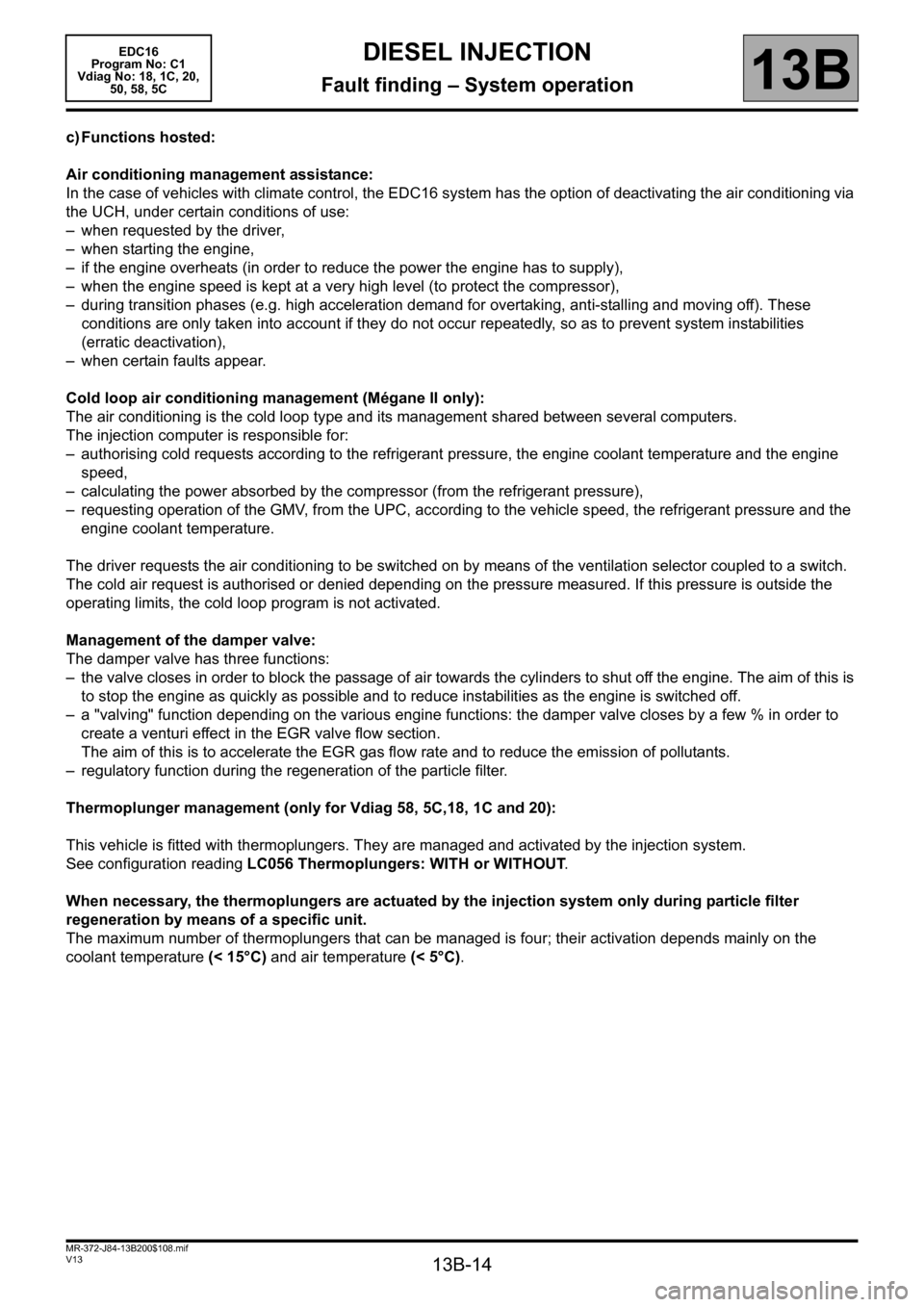
13B-14
MR-372-J84-13B200$108.mif
V13
DIESEL INJECTION
Fault finding – System operation
EDC16
Program No: C1
Vdiag No: 18, 1C, 20,
50, 58, 5C
13B
c) Functions hosted:
Air conditioning management assistance:
In the case of vehicles with climate control, the EDC16 system has the option of deactivating the air conditioning via
the UCH, under certain conditions of use:
– when requested by the driver,
– when starting the engine,
– if the engine overheats (in order to reduce the power the engine has to supply),
– when the engine speed is kept at a very high level (to protect the compressor),
– during transition phases (e.g. high acceleration demand for overtaking, anti-stalling and moving off). These
conditions are only taken into account if they do not occur repeatedly, so as to prevent system instabilities
(erratic deactivation),
– when certain faults appear.
Cold loop air conditioning management (Mégane II only):
The air conditioning is the cold loop type and its management shared between several computers.
The injection computer is responsible for:
– authorising cold requests according to the refrigerant pressure, the engine coolant temperature and the engine
speed,
– calculating the power absorbed by the compressor (from the refrigerant pressure),
– requesting operation of the GMV, from the UPC, according to the vehicle speed, the refrigerant pressure and the
engine coolant temperature.
The driver requests the air conditioning to be switched on by means of the ventilation selector coupled to a switch.
The cold air request is authorised or denied depending on the pressure measured. If this pressure is outside the
operating limits, the cold loop program is not activated.
Management of the damper valve:
The damper valve has three functions:
– the valve closes in order to block the passage of air towards the cylinders to shut off the engine. The aim of this is
to stop the engine as quickly as possible and to reduce instabilities as the engine is switched off.
– a "valving" function depending on the various engine functions: the damper valve closes by a few % in order to
create a venturi effect in the EGR valve flow section.
The aim of this is to accelerate the EGR gas flow rate and to reduce the emission of pollutants.
– regulatory function during the regeneration of the particle filter.
Thermoplunger management (only for Vdiag 58, 5C,18, 1C and 20):
This vehicle is fitted with thermoplungers. They are managed and activated by the injection system.
See configuration reading LC056 Thermoplungers: WITH or WITHOUT.
When necessary, the thermoplungers are actuated by the injection system only during particle filter
regeneration by means of a specific unit.
The maximum number of thermoplungers that can be managed is four; their activation depends mainly on the
coolant temperature (< 15°C) and air temperature (< 5°C).
Page 15 of 365
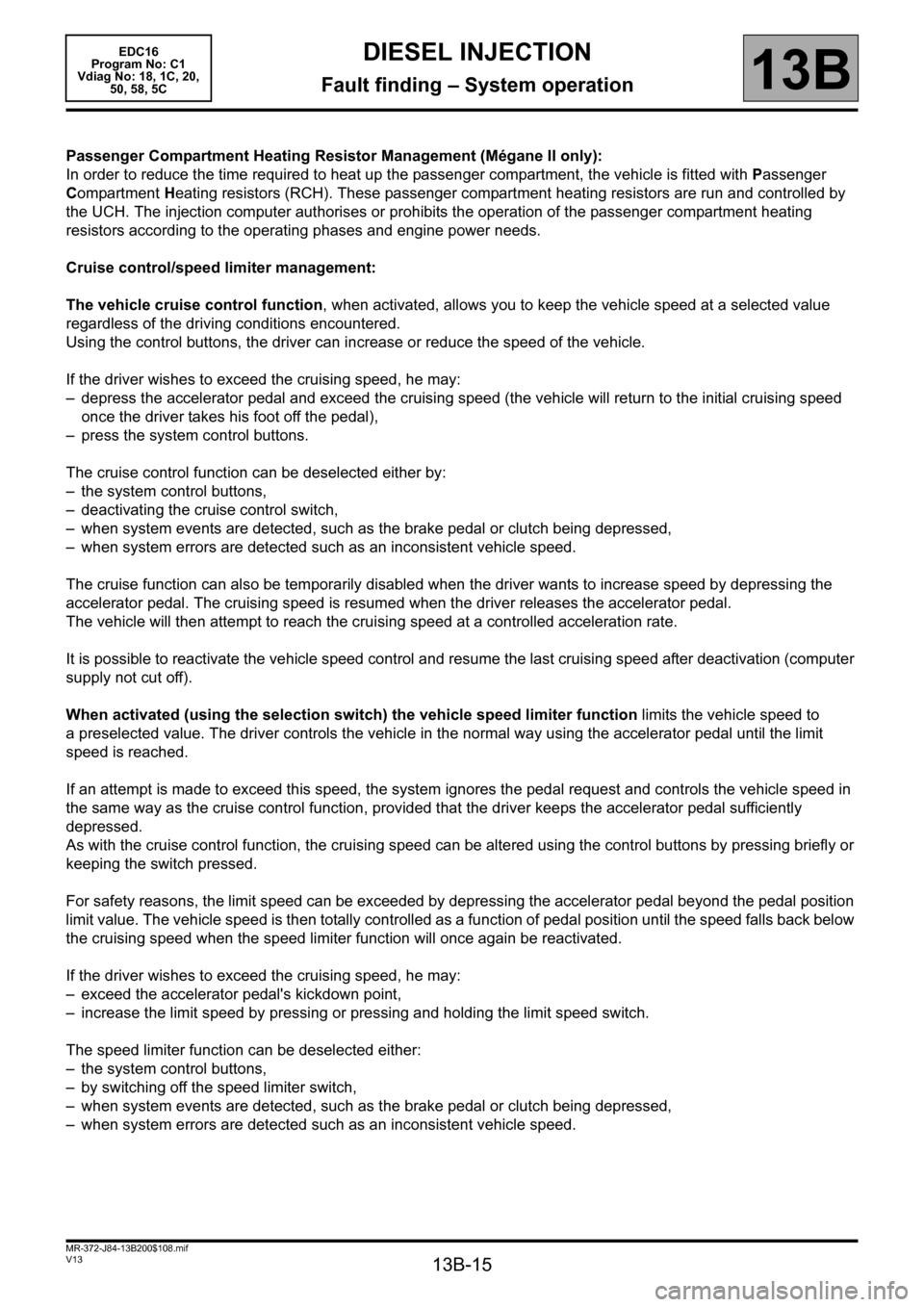
13B-15
MR-372-J84-13B200$108.mif
V13
DIESEL INJECTION
Fault finding – System operation
EDC16
Program No: C1
Vdiag No: 18, 1C, 20,
50, 58, 5C
13B
Passenger Compartment Heating Resistor Management (Mégane II only):
In order to reduce the time required to heat up the passenger compartment, the vehicle is fitted with Passenger
Compartment Heating resistors (RCH). These passenger compartment heating resistors are run and controlled by
the UCH. The injection computer authorises or prohibits the operation of the passenger compartment heating
resistors according to the operating phases and engine power needs.
Cruise control/speed limiter management:
The vehicle cruise control function, when activated, allows you to keep the vehicle speed at a selected value
regardless of the driving conditions encountered.
Using the control buttons, the driver can increase or reduce the speed of the vehicle.
If the driver wishes to exceed the cruising speed, he may:
– depress the accelerator pedal and exceed the cruising speed (the vehicle will return to the initial cruising speed
once the driver takes his foot off the pedal),
– press the system control buttons.
The cruise control function can be deselected either by:
– the system control buttons,
– deactivating the cruise control switch,
– when system events are detected, such as the brake pedal or clutch being depressed,
– when system errors are detected such as an inconsistent vehicle speed.
The cruise function can also be temporarily disabled when the driver wants to increase speed by depressing the
accelerator pedal. The cruising speed is resumed when the driver releases the accelerator pedal.
The vehicle will then attempt to reach the cruising speed at a controlled acceleration rate.
It is possible to reactivate the vehicle speed control and resume the last cruising speed after deactivation (computer
supply not cut off).
When activated (using the selection switch) the vehicle speed limiter function limits the vehicle speed to
a preselected value. The driver controls the vehicle in the normal way using the accelerator pedal until the limit
speed is reached.
If an attempt is made to exceed this speed, the system ignores the pedal request and controls the vehicle speed in
the same way as the cruise control function, provided that the driver keeps the accelerator pedal sufficiently
depressed.
As with the cruise control function, the cruising speed can be altered using the control buttons by pressing briefly or
keeping the switch pressed.
For safety reasons, the limit speed can be exceeded by depressing the accelerator pedal beyond the pedal position
limit value. The vehicle speed is then totally controlled as a function of pedal position until the speed falls back below
the cruising speed when the speed limiter function will once again be reactivated.
If the driver wishes to exceed the cruising speed, he may:
– exceed the accelerator pedal's kickdown point,
– increase the limit speed by pressing or pressing and holding the limit speed switch.
The speed limiter function can be deselected either:
– the system control buttons,
– by switching off the speed limiter switch,
– when system events are detected, such as the brake pedal or clutch being depressed,
– when system errors are detected such as an inconsistent vehicle speed.
Page 16 of 365
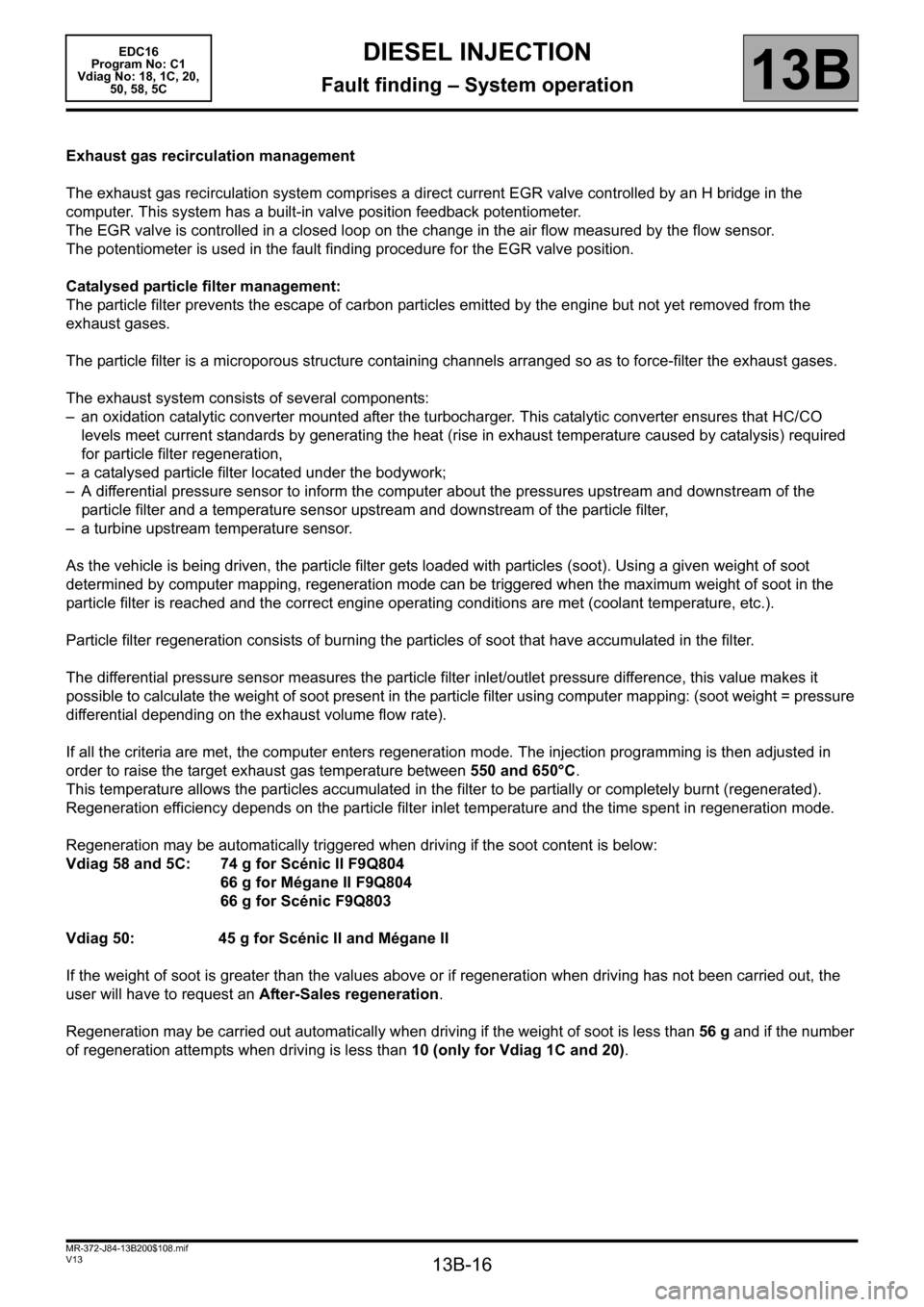
13B-16
MR-372-J84-13B200$108.mif
V13
DIESEL INJECTION
Fault finding – System operation
EDC16
Program No: C1
Vdiag No: 18, 1C, 20,
50, 58, 5C
13B
Exhaust gas recirculation management
The exhaust gas recirculation system comprises a direct current EGR valve controlled by an H bridge in the
computer. This system has a built-in valve position feedback potentiometer.
The EGR valve is controlled in a closed loop on the change in the air flow measured by the flow sensor.
The potentiometer is used in the fault finding procedure for the EGR valve position.
Catalysed particle filter management:
The particle filter prevents the escape of carbon particles emitted by the engine but not yet removed from the
exhaust gases.
The particle filter is a microporous structure containing channels arranged so as to force-filter the exhaust gases.
The exhaust system consists of several components:
– an oxidation catalytic converter mounted after the turbocharger. This catalytic converter ensures that HC/CO
levels meet current standards by generating the heat (rise in exhaust temperature caused by catalysis) required
for particle filter regeneration,
– a catalysed particle filter located under the bodywork;
– A differential pressure sensor to inform the computer about the pressures upstream and downstream of the
particle filter and a temperature sensor upstream and downstream of the particle filter,
– a turbine upstream temperature sensor.
As the vehicle is being driven, the particle filter gets loaded with particles (soot). Using a given weight of soot
determined by computer mapping, regeneration mode can be triggered when the maximum weight of soot in the
particle filter is reached and the correct engine operating conditions are met (coolant temperature, etc.).
Particle filter regeneration consists of burning the particles of soot that have accumulated in the filter.
The differential pressure sensor measures the particle filter inlet/outlet pressure difference, this value makes it
possible to calculate the weight of soot present in the particle filter using computer mapping: (soot weight = pressure
differential depending on the exhaust volume flow rate).
If all the criteria are met, the computer enters regeneration mode. The injection programming is then adjusted in
order to raise the target exhaust gas temperature between 550 and 650°C.
This temperature allows the particles accumulated in the filter to be partially or completely burnt (regenerated).
Regeneration efficiency depends on the particle filter inlet temperature and the time spent in regeneration mode.
Regeneration may be automatically triggered when driving if the soot content is below:
Vdiag 58 and 5C: 74 g for Scénic II F9Q804
66 g for Mégane II F9Q804
66 g for Scénic F9Q803
Vdiag 50: 45 g for Scénic II and Mégane II
If the weight of soot is greater than the values above or if regeneration when driving has not been carried out, the
user will have to request an After-Sales regeneration.
Regeneration may be carried out automatically when driving if the weight of soot is less than 56 g and if the number
of regeneration attempts when driving is less than 10 (only for Vdiag 1C and 20).
Page 17 of 365
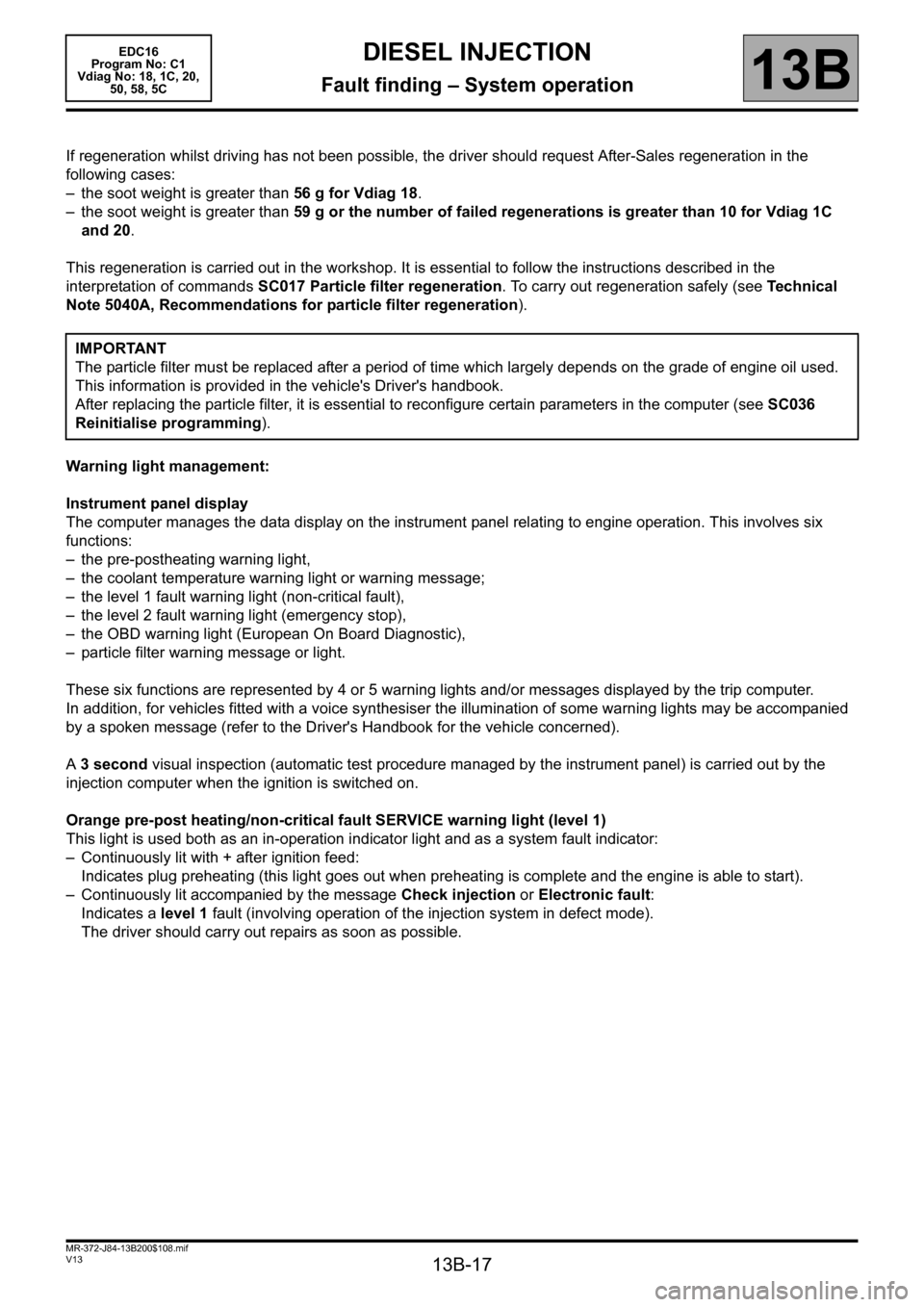
13B-17
MR-372-J84-13B200$108.mif
V13
DIESEL INJECTION
Fault finding – System operation
EDC16
Program No: C1
Vdiag No: 18, 1C, 20,
50, 58, 5C
13B
If regeneration whilst driving has not been possible, the driver should request After-Sales regeneration in the
following cases:
– the soot weight is greater than 56 g for Vdiag 18.
– the soot weight is greater than 59 g or the number of failed regenerations is greater than 10 for Vdiag 1C
and 20.
This regeneration is carried out in the workshop. It is essential to follow the instructions described in the
interpretation of commands SC017 Particle filter regeneration. To carry out regeneration safely (see Te c h n i c a l
Note 5040A, Recommendations for particle filter regeneration).
Warning light management:
Instrument panel display
The computer manages the data display on the instrument panel relating to engine operation. This involves six
functions:
– the pre-postheating warning light,
– the coolant temperature warning light or warning message;
– the level 1 fault warning light (non-critical fault),
– the level 2 fault warning light (emergency stop),
– the OBD warning light (European On Board Diagnostic),
– particle filter warning message or light.
These six functions are represented by 4 or 5 warning lights and/or messages displayed by the trip computer.
In addition, for vehicles fitted with a voice synthesiser the illumination of some warning lights may be accompanied
by a spoken message (refer to the Driver's Handbook for the vehicle concerned).
A 3 second visual inspection (automatic test procedure managed by the instrument panel) is carried out by the
injection computer when the ignition is switched on.
Orange pre-post heating/non-critical fault SERVICE warning light (level 1)
This light is used both as an in-operation indicator light and as a system fault indicator:
– Continuously lit with + after ignition feed:
Indicates plug preheating (this light goes out when preheating is complete and the engine is able to start).
– Continuously lit accompanied by the message Check injection or Electronic fault:
Indicates a level 1 fault (involving operation of the injection system in defect mode).
The driver should carry out repairs as soon as possible. IMPORTANT
The particle filter must be replaced after a period of time which largely depends on the grade of engine oil used.
This information is provided in the vehicle's Driver's handbook.
After replacing the particle filter, it is essential to reconfigure certain parameters in the computer (see SC036
Reinitialise programming).
Page 18 of 365
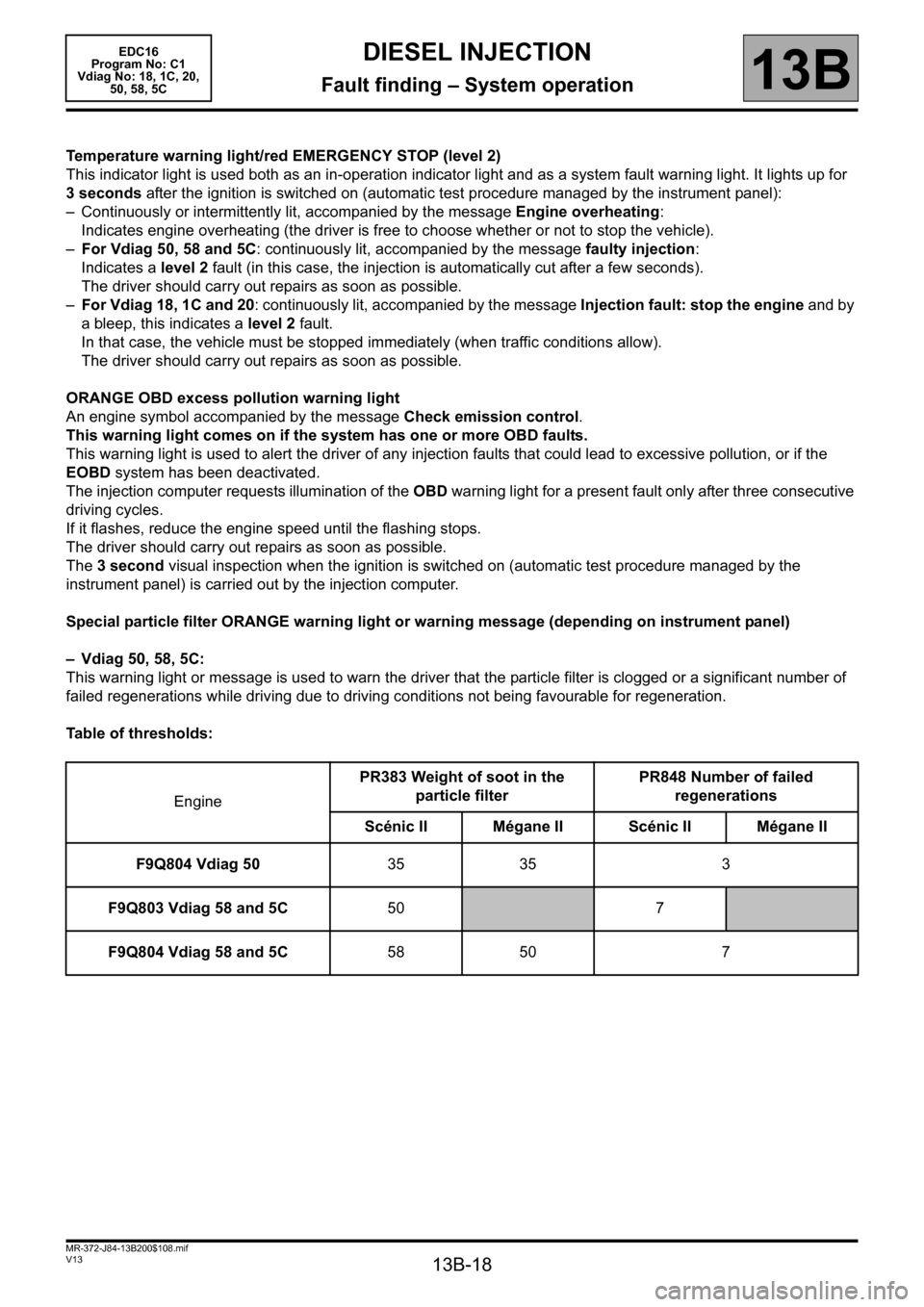
13B-18
MR-372-J84-13B200$108.mif
V13
DIESEL INJECTION
Fault finding – System operation
EDC16
Program No: C1
Vdiag No: 18, 1C, 20,
50, 58, 5C
13B
Temperature warning light/red EMERGENCY STOP (level 2)
This indicator light is used both as an in-operation indicator light and as a system fault warning light. It lights up for
3 seconds after the ignition is switched on (automatic test procedure managed by the instrument panel):
– Continuously or intermittently lit, accompanied by the message Engine overheating:
Indicates engine overheating (the driver is free to choose whether or not to stop the vehicle).
–For Vdiag 50, 58 and 5C: continuously lit, accompanied by the message faulty injection:
Indicates a level 2 fault (in this case, the injection is automatically cut after a few seconds).
The driver should carry out repairs as soon as possible.
–For Vdiag 18, 1C and 20: continuously lit, accompanied by the message Injection fault: stop the engine and by
a bleep, this indicates a level 2 fault.
In that case, the vehicle must be stopped immediately (when traffic conditions allow).
The driver should carry out repairs as soon as possible.
ORANGE OBD excess pollution warning light
An engine symbol accompanied by the message Check emission control.
This warning light comes on if the system has one or more OBD faults.
This warning light is used to alert the driver of any injection faults that could lead to excessive pollution, or if the
EOBD system has been deactivated.
The injection computer requests illumination of the OBD warning light for a present fault only after three consecutive
driving cycles.
If it flashes, reduce the engine speed until the flashing stops.
The driver should carry out repairs as soon as possible.
The 3 second visual inspection when the ignition is switched on (automatic test procedure managed by the
instrument panel) is carried out by the injection computer.
Special particle filter ORANGE warning light or warning message (depending on instrument panel)
– Vdiag 50, 58, 5C:
This warning light or message is used to warn the driver that the particle filter is clogged or a significant number of
failed regenerations while driving due to driving conditions not being favourable for regeneration.
Table of thresholds:
EnginePR383 Weight of soot in the
particle filterPR848 Number of failed
regenerations
Scénic II Mégane IIScénic II Mégane II
F9Q804 Vdiag 5035 35 3
F9Q803 Vdiag 58 and 5C50
7
F9Q804 Vdiag 58 and 5C58 50 7
Page 19 of 365
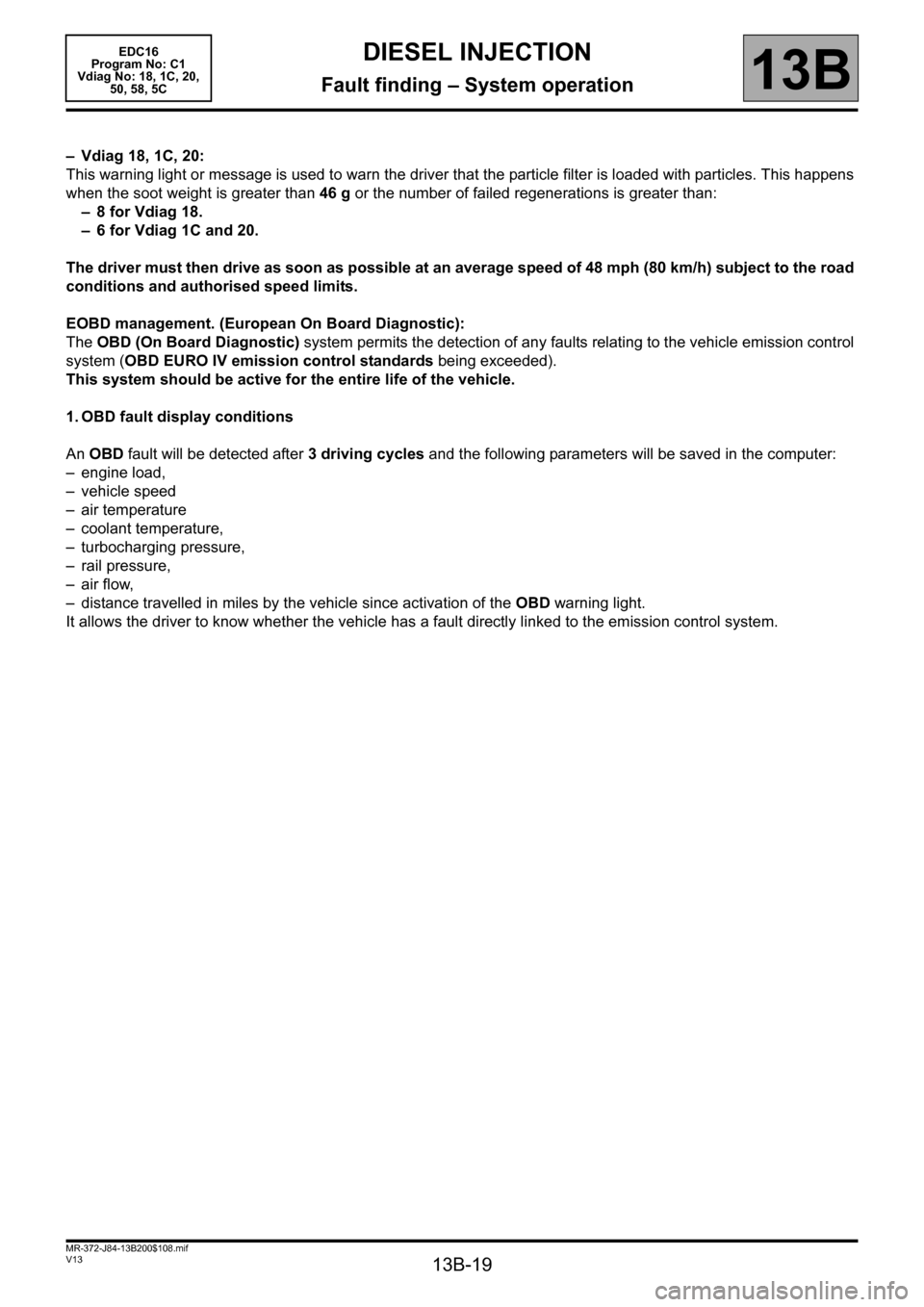
13B-19
MR-372-J84-13B200$108.mif
V13
DIESEL INJECTION
Fault finding – System operation
EDC16
Program No: C1
Vdiag No: 18, 1C, 20,
50, 58, 5C
13B
– Vdiag 18, 1C, 20:
This warning light or message is used to warn the driver that the particle filter is loaded with particles. This happens
when the soot weight is greater than 46 g or the number of failed regenerations is greater than:
– 8 for Vdiag 18.
– 6 for Vdiag 1C and 20.
The driver must then drive as soon as possible at an average speed of 48 mph (80 km/h) subject to the road
conditions and authorised speed limits.
EOBD management. (European On Board Diagnostic):
The OBD (On Board Diagnostic) system permits the detection of any faults relating to the vehicle emission control
system (OBD EURO IV emission control standards being exceeded).
This system should be active for the entire life of the vehicle.
1. OBD fault display conditions
An OBD fault will be detected after 3 driving cycles and the following parameters will be saved in the computer:
– engine load,
– vehicle speed
– air temperature
– coolant temperature,
– turbocharging pressure,
– rail pressure,
– air flow,
– distance travelled in miles by the vehicle since activation of the OBD warning light.
It allows the driver to know whether the vehicle has a fault directly linked to the emission control system.
Page 20 of 365
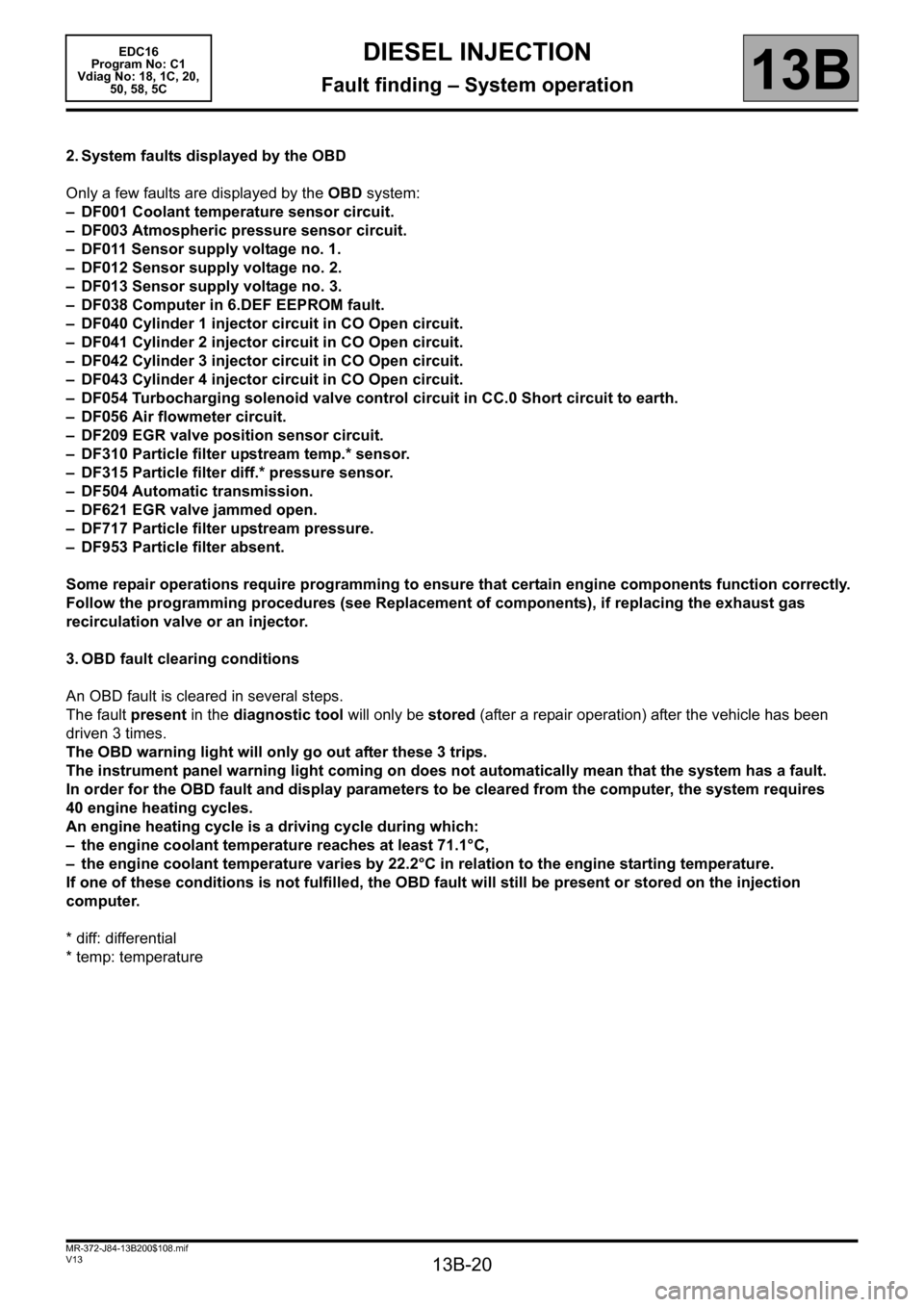
13B-20
MR-372-J84-13B200$108.mif
V13
DIESEL INJECTION
Fault finding – System operation
EDC16
Program No: C1
Vdiag No: 18, 1C, 20,
50, 58, 5C
13B
2. System faults displayed by the OBD
Only a few faults are displayed by the OBD system:
– DF001 Coolant temperature sensor circuit.
– DF003 Atmospheric pressure sensor circuit.
– DF011 Sensor supply voltage no. 1.
– DF012 Sensor supply voltage no. 2.
– DF013 Sensor supply voltage no. 3.
– DF038 Computer in 6.DEF EEPROM fault.
– DF040 Cylinder 1 injector circuit in CO Open circuit.
– DF041 Cylinder 2 injector circuit in CO Open circuit.
– DF042 Cylinder 3 injector circuit in CO Open circuit.
– DF043 Cylinder 4 injector circuit in CO Open circuit.
– DF054 Turbocharging solenoid valve control circuit in CC.0 Short circuit to earth.
– DF056 Air flowmeter circuit.
– DF209 EGR valve position sensor circuit.
– DF310 Particle filter upstream temp.* sensor.
– DF315 Particle filter diff.* pressure sensor.
– DF504 Automatic transmission.
– DF621 EGR valve jammed open.
– DF717 Particle filter upstream pressure.
– DF953 Particle filter absent.
Some repair operations require programming to ensure that certain engine components function correctly.
Follow the programming procedures (see Replacement of components), if replacing the exhaust gas
recirculation valve or an injector.
3. OBD fault clearing conditions
An OBD fault is cleared in several steps.
The fault present in the diagnostic tool will only be stored (after a repair operation) after the vehicle has been
driven 3 times.
The OBD warning light will only go out after these 3 trips.
The instrument panel warning light coming on does not automatically mean that the system has a fault.
In order for the OBD fault and display parameters to be cleared from the computer, the system requires
40 engine heating cycles.
An engine heating cycle is a driving cycle during which:
– the engine coolant temperature reaches at least 71.1°C,
– the engine coolant temperature varies by 22.2°C in relation to the engine starting temperature.
If one of these conditions is not fulfilled, the OBD fault will still be present or stored on the injection
computer.
* diff: differential
* temp: temperature